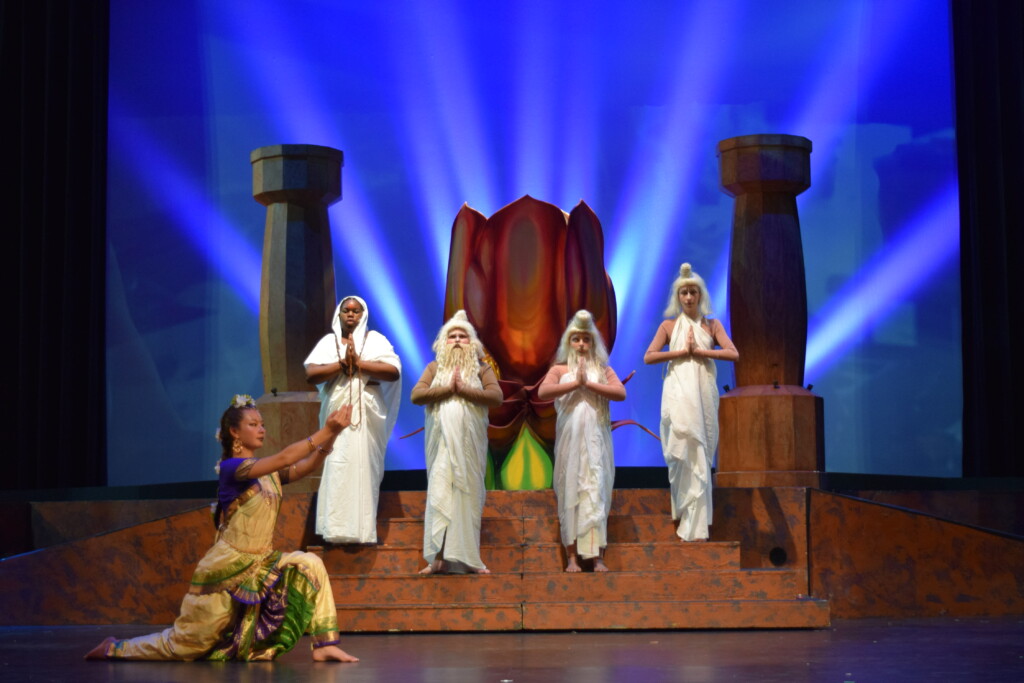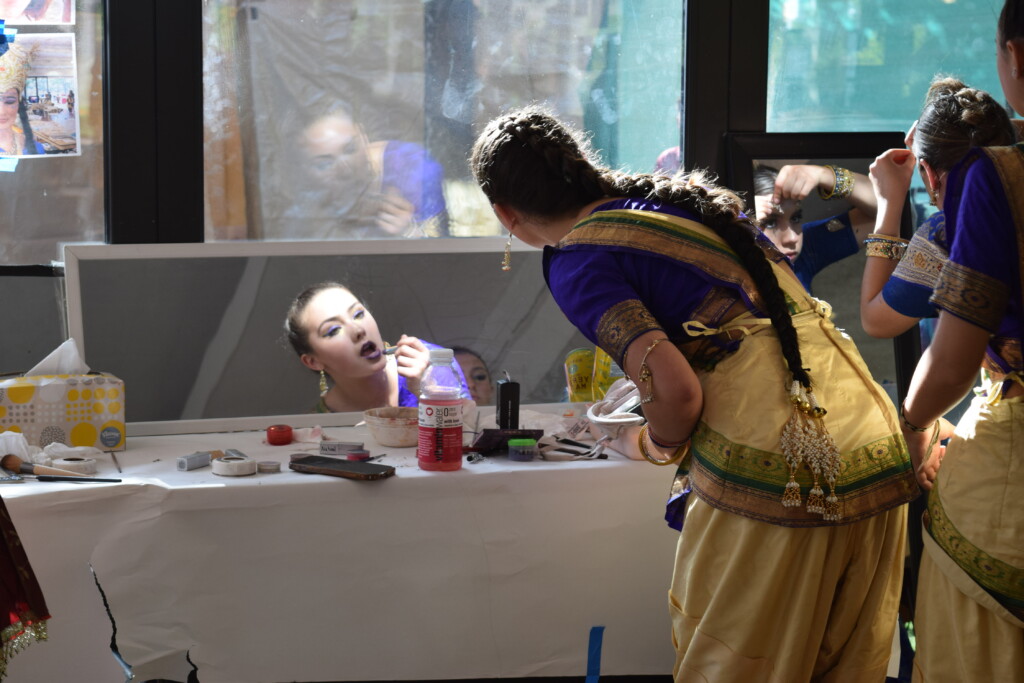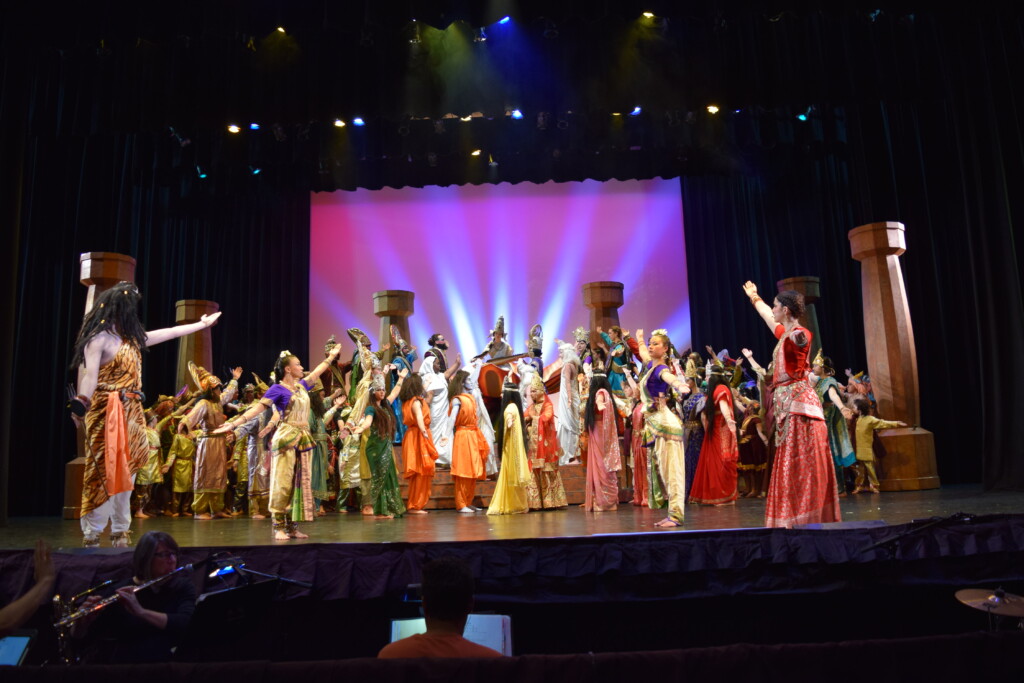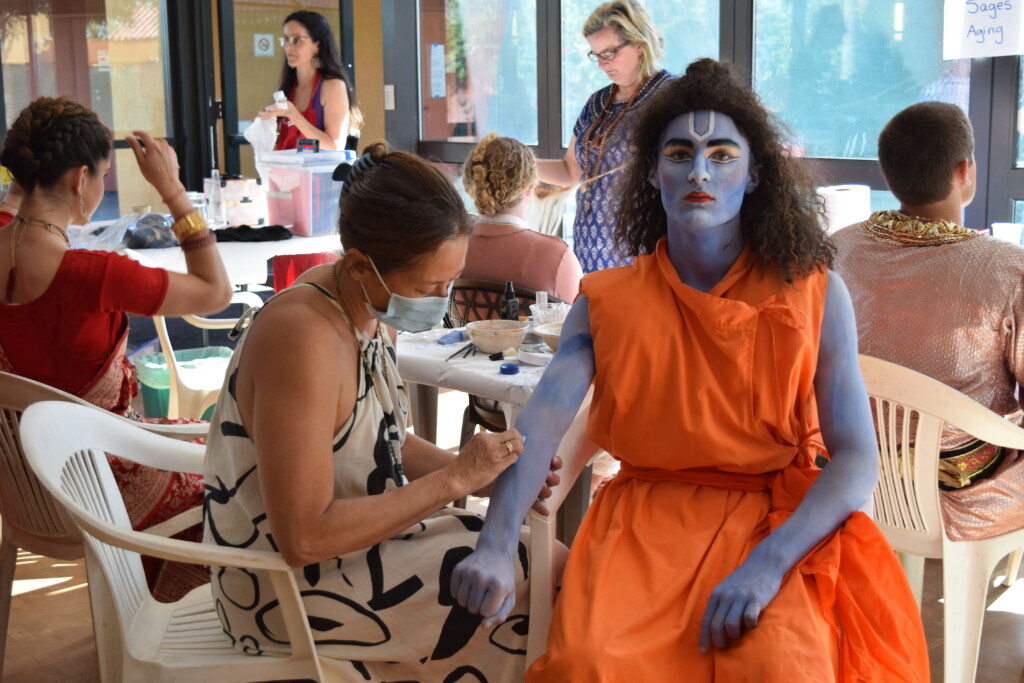Entertainment: ‘Ramayana’ theatrical pageant highlights mythology of Hindu culture
For 45 years, MMS students of all grades bring epic to life on stage
![]()

Erik Howley as “Lord Shiva” (front left) and Ona Musoll-Buendia as the “Goddess Parvati” (front right), ask the “Goddess Sarasvati” for blessings so the story they are telling can be “brought to life” for all to see the tale as it unfolds. Photo by Kaylee Arca
By Kaylee Arca
Audiences of teary-eyed proud parents watched their children bring monkeys, monsters, and deities to life during Mount Madonna School’s 45th annual production of the Hindu mythological show “Ramayana!”
Bedecked in dazzling costumes and intricate masks, more than 175 students, from preschool to high school seniors, performed this modernized cultural epic for four shows in early June at the Mexican Heritage Theater in San Jose.

Photo by Kaylee Arca
“Ramayana!” is a musical retelling of the Hindu story “Ramayana,” written by the ancient Indian poet Valmiki. Mount Madonna’s version included original songs, traditional Indian dances, and martial arts scenes as princes “Rāma” and “Lakshmana” journeyed to Lanka in their quest to rescue “Princess Sītā” from “King Rāvana.”
The school’s retelling was written and translated by Baba Hari Dass, a monk who founded the Mount Madonna Center. The entire story is traditionally told during a 10-day period. However, Baba Heri Dass condensed the story for the 3.5-hour musical production.
Throughout the musical, audiences experienced demons and monster rigs come to life, including a fire-breathing dragon and a 25-foot tall puppet of “Kumbhakarna,” the younger brother of “King Ravana.”
This year’s production was directed by Chelsea Otterness, the school’s performing arts director.
“It’s a well-known story, and if you were to read it, it would be the same sequence of events,” Otterness said. “But in terms of the jokes we tell or the vernacular we chose, we’re doing an English translation. I took some liberties, which is fine. But the story itself is untouchable because it’s ancient.”
Otterness became the performing arts director three years ago. She’s maintained the tradition and worked to align “Ramayana!” with Indian culture.

Erik Howley as “Lord Shiva” (front left) and Ona Musoll-Buendia as the “Goddess Parvati” (front right), ask the “Goddess Sarasvati” for blessings so the story they are telling can be “brought to life” for all to see the tale as it unfolds.
Photos by Kaylee Arca
“I had no experience at all, but I had a lot of care,” she said. “I care a lot about Baba Hari Dass’ teachings to meditate every day, meet people without fear, work honestly, and play.”
All of the school’s students performed in “Ramayana!” The high school seniors who played the lead roles performed 14 years ago as preschoolers playing little forest animals.
“You’ll see the forest animals and then you can project into the future that those little ones will then be the lead characters,” she said. “So it’s something that the kids look forward to.”
Anya Gonzalez, 18, a high school senior, once played an eagle among the forest animals. In her final run of the show, she played the female lead Princess Sītā.
“I like the way our play is, Sita doesn’t have to be a damsel in distress,” Gonzalez said. “I think there’s a lot of space for my character to be courageous and resilient.”
Erik Howley, 17 , portrayed “Lord Shiva,” the god of destruction, He also served as the narrator throughout the production.
“My favorite part about my role is that I get to bring the story to life,” Howley said. “I set the groundwork for everyone to show themselves.”
The most challenging part of playing Lord Shiva is remembering all of the dialogue and sitting in makeup for a long time to get painted blue, he said.
Howley and the cast guide the audience through the conflict of good and evil.

Parent and volunteer Sandy Shaw applies blue body paint to Cooper Padilla, cast as Lord Rama in Madonna School’s 45th annual musical “Ramayana!”
Photos by Kaylee Arca
“It’s a story that’s been told for thousands of years with archetypes and mythology that you find in a lot of global traditions, like the Ramayana,” Otterness said. “For example, the dualities of good and evil are played out on stage.”
Otterness also takes the high school seniors on a trip to explore India every year and learn about that country’s culture and traditions.
“It’s more than just tourism,” she said. “It’s like getting to know the educational systems in another country.”
As part of the production, groups of students learned the Indian classical dance form “Bharatanatyam,” as well as traditional bow and stick dances, choreographed fight scenes with staffs, and how to sing in the Hindu tradition. Students also dove into their roles with a character study to help the characters come to life.
“So a lot of these dances have a root in India and have been a legacy that we’ve passed along,” Otterness said. “We were able to add a Bollywood or hip-hop twist, like our monkeys do a little hip-hop. So students learn a lot of things and they have to investigate their character.”
Kaylee Arca is a Morgan Hill-based freelance writer.

